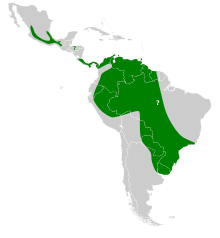| Brazilian brown bat | |
|---|---|

| |
| A preserved Eptesicus brasiliensis specimen | |
| Scientific classification | |
| Domain: | Eukaryota |
| Kingdom: | Animalia |
| Phylum: | Chordata |
| Class: | Mammalia |
| Order: | Chiroptera |
| Family: | Vespertilionidae |
| Genus: | Eptesicus |
| Species: | E. brasiliensis
|
| Binomial name | |
| Eptesicus brasiliensis Desmarest, 1819
| |

| |
The Brazilian brown bat (Eptesicus brasiliensis) is a bat species from South and Central America.
YouTube Encyclopedic
-
1/3Views:6911 349623
-
Mexican free-tailed bat - Video Learning - WizScience.com
-
VAMPIRE BATS CAUGHT FEEDING ON HUMANS WHILE THEY SLEEP, CONFIRMED
-
Steve Kardian, Gracie Jiu-Jitsu Baseball Bat Choke-Intermediate
Transcription
Description
The Brazilian brown bat is medium in size, being 85–91 mm (3.3–3.6 in) long, and has forearms that are 41–47 mm (1.6–1.9 in) long.[2] It has a long tail and triangular ears.[3]
Habitat
The Brazilian brown bat is found in forests and forest edges, primarily near sources of water like streams and rivers. They roost in hollow trees and houses.[2][3]
References
- ^ Barquez, R.; Perez, S.; Miller, B.; Diaz, M. (2016). "Eptesicus brasiliensis". IUCN Red List of Threatened Species. 2016: e.T7916A22114459. doi:10.2305/IUCN.UK.2016-1.RLTS.T7916A22114459.en. Retrieved 8 January 2023.
- ^ a b Bats of Colima, Mexico. Animal natural history series. Norman: University of Oklahoma press Sam Noble Oklahoma museum of natural history. 2016. pp. 186–187. ISBN 978-0-8061-5216-5.
- ^ a b Reid, Fiona (2009). A field guide to the mammals of Central America & Southeast Mexico (2nd ed.). Oxford ; New York: Oxford University Press. p. 157. ISBN 978-0-19-534322-9. OCLC 237402526.

